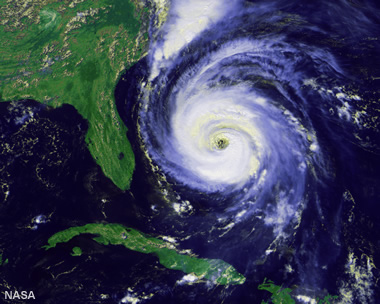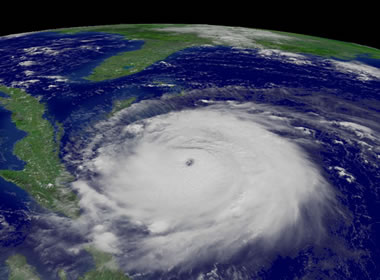Why Was the Name Lee Used Again Hurricane

Hurricane Fran: Satellite prototype of a hurricane named "Fran." Hurricane Fran was a big, powerful, destructive hurricane that made landfall nigh Cape Fearfulness, North Carolina on September 5, 1996. Fran was the 6th named storm of the 1996 hurricane flavour. It was so destructive that the name "Fran" was retired from use. Satellite image by NASA.
Why are Hurricanes Named?
Hurricanes occur every year, and sometimes two or three hurricanes can be active at the same time. Using names for these storms makes it much easier for meteorologists, researchers, emergency response workers, ship captains and citizens to communicate about specific hurricanes and exist conspicuously understood.
For that reason, the World Meteorological Organization develops a list of names that are assigned in alphabetical order to tropical storms as they are discovered in each hurricane flavor. Names can be repeated after an interval of six years, but the names of especially severe storms are permanently retired from use.
| Names used for Atlantic Tropical Storms | |||||
| 2019 | 2020 | 2021 | 2022 | 2023 | 2024 |
| Andrea | Arthur | Ana | Alex | Arlene | Alberto |
| Barry | Bertha | Pecker | Bonnie | Bret | Beryl |
| Chantal | Cristobal | Claudette | Colin | Cindy | Chris |
| Dorian | Dolly | Danny | Danielle | Don | Debby |
| Erin | Edouard | Elsa | Earl | Emily | Ernesto |
| Fernand | Fay | Fred | Fiona | Franklin | Francine |
| Gabrielle | Gonzalo | Grace | Gaston | Gert | Gordon |
| Humberto | Hanna | Henri | Hermine | Harold | Helene |
| Imelda | Isaias | Ida | Ian | Idalia | Isaac |
| Jerry | Josephine | Julian | Julia | Jose | Joyce |
| Karen | Kyle | Kate | Karl | Katia | Kirk |
| Lorenzo | Laura | Larry | Lisa | Lee | Leslie |
| Melissa | Marco | Mindy | Martin | Margot | Milton |
| Nestor | Nana | Nicholas | Nicole | Nigel | Nadine |
| Olga | Omar | Odette | Owen | Ophelia | Oscar |
| Pablo | Paulette | Peter | Paula | Philippe | Patty |
| Rebekah | Rene | Rose | Richard | Rina | Rafael |
| Sebastien | Sally | Sam | Shary | Sean | Sara |
| Tanya | Teddy | Teresa | Tobias | Tammy | Tony |
| Van | Vicky | Victor | Virginie | Vince | Valerie |
| Wendy | Wilfred | Wanda | Walter | Whitney | William |
Recent and Hereafter Hurricane Names
In the Atlantic Ocean, tropical storms that reach a sustained wind speed of 39 miles per 60 minutes are given a proper noun, such as "Tropical Storm Fran." If the storm reaches a sustained air current speed of 74 miles per hour, it is called a hurricane - such as "Hurricane Fran." So, hurricanes are not given names, tropical storms are given names, and they retain their name if they develop into a hurricane. The names used for contempo and future Atlantic storms are listed in the tabular array on this page.
| Retired Hurricane Names past Year | ||||
| 1979 David Frederic | 1980 Allen | 1981 | 1982 | 1983 Alicia |
| 1984 | 1985 Elena Gloria | 1986 | 1987 | 1988 Gilbert Joan |
| 1989 Hugo | 1990 Diana Klaus | 1991 Bob | 1992 Andrew | 1993 |
| 1994 | 1995 Luis Marilyn Opal Roxanne | 1996 Cesar Fran Hortense | 1997 | 1998 Georges Mitch |
| 1999 Floyd Lenny | 2000 Keith | 2001 Allison Iris Michelle | 2002 Isidore Lili | 2003 Fabian Isabel Juan |
| 2004 Charley Frances Ivan Jeanne | 2005 Dennis Katrina Rita Stan Wilma | 2006 | 2007 Dean Felix Noel | 2008 Gustav Ike Paloma |
| 2009 | 2010 Igor Tomas | 2011 Irene | 2012 Sandy | 2013 Ingrid |
| 2014 | 2015 Erika Joaquin | 2016 Matthew Otto | 2017 Harvey Irma Maria Nate | 2018 Florence Michael |
| 2019 Dorian | 2020 Laura Eta Iota | |||
History of Atlantic Hurricane Names
Names have been given to Atlantic hurricanes for a few hundred years. People living in the Caribbean area Islands named storms after the saint of the 24-hour interval from the Roman Cosmic liturgical calendar for the twenty-four hour period on which the hurricane occurred such as "Hurricane San Felipe." When ii hurricanes struck on the same date in different years, the hurricanes would be referred to by names such as "Hurricane San Felipe the first" and "Hurricane San Felipe the second."
In the early days of meteorology in the Us, storms were named with a latitude / longitude designation representing the location where the tempest originated. These names were difficult to remember, hard to communicate and subject to errors. During the 2nd World War, armed services meteorologists working in the Pacific began to utilise women'due south names for storms. That naming method made communication so easy that in 1953 it was adopted by the National Hurricane Eye for employ on storms originating in the Atlantic Ocean. Once this do started, hurricane names chop-chop became part of common language, and public awareness of hurricanes increased dramatically.
Retired in 2022 and 2020
In 2019, Hurricane Dorian caused significant amercement and fatalities. The same is true of hurricanes Laura, Eta, and Iota in 2020. Out of respect for the people who suffered losses, these names were retired and will not be used again for tropical storms. A list of names that take been retired from 1979-2020 can be viewed on this page.
In 1978, meteorologists watching storms in the eastern North Pacific began using men'due south names for one-half of the storms. Meteorologists for the Atlantic Sea began using men's names in 1979. For each year a list of 21 names, each starting with a different letter of the alphabet, was developed and arranged in alphabetical order (names beginning with the letters Q, U, X, Y and Z were not used). The first tropical storm of the yr was given the name beginning with the letter "A," the second with the letter of the alphabet "B" and so on through the alphabet. During even-numbered years, men'south names were given to the odd-numbered storms and during odd-numbered years, women's names were given to odd-numbered storms (see the tabular array for recent name lists).
Today, the Globe Meteorological Organization maintains the lists of names for tropical storms effectually the world. For the Atlantic hurricane names, there are half dozen lists which are reused every six years.

Hurricane Frances: Satellite paradigm of a hurricane named "Frances" equally information technology approaches Florida. Satellite image by NASA. The name "Frances" was retired after the hurricane caused major damage in 2004.
Retired Hurricane Names
The only change that is made to the listing of Atlantic hurricane names is the occasional retirement of a name. This is done when a hurricane causes so much death and destruction that reuse of the same name would be insensitive to the people who suffered losses. When that happens the World Meteorological System replaces the proper name. For example, "Katrina" has been retired from the proper noun list and will not be used once more.
A list of hurricane names that have been retired since the current proper noun list arrangement was established in 1979 is shown on this webpage. In addition to retirements, there are a few names that were simply changed. For instance, on the 2007 list the names Dean, Felix and Noel were replaced with Dorian, Fernand and Nestor for the 2013 listing.
| Supplemental Atlantic Tropical Storm Names | |||||
| Storm # | Name | Storm # | Proper name | Storm # | Proper name |
| 22 | Adria | 29 | Heath | 36 | Orlanda |
| 23 | Braylen | 30 | Isla | 37 | Pax |
| 24 | Caridad | 31 | Jacobus | 38 | Ronin |
| 25 | Deshawn | 32 | Kenzie | 39 | Sophie |
| 26 | Emery | 33 | Lucio | twoscore | Tayshaun |
| 27 | Foster | 34 | Makayla | 41 | Viviana |
| 28 | Gemma | 35 | Nolan | 42 | Will |
When In that location Are More than 21 Named Storms
There are unremarkably fewer than 21 named tropical storms in any calendar twelvemonth. In the rare years when more than 21 storms are named, a supplemental list is used. In the by, the boosted storms were given names from the Greek alphabet: Blastoff, Beta, Gamma, Delta, and so on. Even so, this system led to confusion in the record-breaking Atlantic storm season of 2020, when multiple storms with similar-sounding names (Zeta, Eta, and Theta) were concurrently agile. In March 2021, the World Meteorological Organization Hurricane Committee made the determination to cease using the Greek alphabet, and adult a replacement list. [ane] This new supplemental list can be seen in the accompanying table.
Naming Tropical Storms Outside of the Atlantic
Tropical storms occur in the Pacific Ocean, and meteorologists working at that place accept developed naming systems for them. Carve up naming systems are maintained for Eastern Northward Pacific Storms and Primal North Pacific Storms. Visit the National Hurricane Centre to run across lists and pronunciations of the names used in these areas. The World Meteorological Organization maintains the lists of names for tropical storms effectually the world.
Notice Other Topics on Geology.com:
 Rocks: Galleries of igneous, sedimentary and metamorphic stone photos with descriptions. |  Minerals: Information nigh ore minerals, precious stone materials and stone-forming minerals. |
 Volcanoes: Articles almost volcanoes, volcanic hazards and eruptions past and present. |  Gemstones: Colorful images and articles about diamonds and colored stones. |
 General Geology: Articles about geysers, maars, deltas, rifts, common salt domes, h2o, and much more! |  Geology Store: Hammers, field numberless, hand lenses, maps, books, hardness picks, gilt pans. |
 |  Diamonds: Learn about the properties of diamond, its many uses, and diamond discoveries. |
Source: https://geology.com/hurricanes/hurricane-names.shtml
0 Response to "Why Was the Name Lee Used Again Hurricane"
Post a Comment